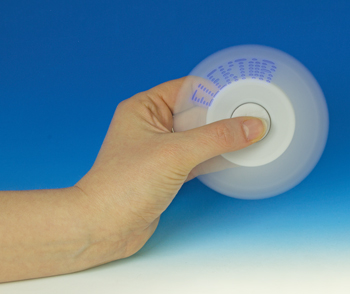Article
POV Fidget Spinner
Rotating animations

Actually fidget spinners are totally out, but the one described here is DIY and it and can display user-programmed illuminated text strings and animations. That might be enough to get a bit of attention this summer.Every few years, a gimmick craze sweeps over the world like a tsunami. Yo-yos, pendulum balls, superballs, Rubik cubes, slime, tamagotchi, loom bands — and last year, fidget spinners. These fads usually ebb away just as quickly as they arrive, and last summer’s big hit, the fidget spinner, is no different. At that time kids and adults alike absolutely had to have one, but now it is completely out. Totally uncool.
Gerber file
CAM/CAD data for the PCB referred to in this article is available as a Gerber file. Elektor GREEN and GOLD members can exclusively download these files for free as part of their membership. Gerber files allow a PCB to be produced on an appropriate device available locally, or through an online PCB manufacturing service.
Elektor recommends the Elektor PCB Service service from its business partner Eurocircuits or AISLER as the best services for its own prototypes and volume production.
The use of our Gerber files is provided under a modified Creative Commons license. Creative Commons offers authors, scientists, educators and other creatives the freedom to handle their copyright in a more free way without losing their ownership.
PCB
Extra info / Update
Tags: POV, fidget spinner, 3D printing
Level: Advanced
Time required: 1 day approx.
Tools and equipment: SMD soldering station, 3D printer, PC, FT232R USB/Serial BoB
Cost: €35 / £30 / $45 approx. (without housing)
Level: Advanced
Time required: 1 day approx.
Tools and equipment: SMD soldering station, 3D printer, PC, FT232R USB/Serial BoB
Cost: €35 / £30 / $45 approx. (without housing)
Component list
@ www.elektor.com
Bare board: 170184-1
Programmed microcontroller: 170184-41
FT232R USB/Serial BoB: 110553-91
Component List
Resistors
Default: 1%, 125mW, SMD0805
R1,R10,R13 = 10kOhm
R2–R8 = 470Ohm
R9,R14 = 220kOhm
R11 = 100kOhm
R12 = 12kOhm
R15 = 1kOhm
Capacitors
Default: 10%, X7R, SMD0805
C1,C5,C7 = 10µF 10V
C2,C3,C4,C5,C6,C8,C9 = 100nF 50V
Semiconductors
IC1 = ATmega328PB-AU, TQFP32 (Atmel), programmed
IC2 = LE33CD, LDO voltage regulator, 3.3V, 0.1A (ST)
IC3 = TLE4905L (Infineon)
T1,T2 = FDN358P, SOT23 (ON semi)
T3 = BSS138
D1,D2 = BAV70, dual diode, SOT23
LED1–LED7 = LED, blue, SMD0805
Miscellaneous
S1 = MC32882 pushbutton switch
K1 = 6-pin (2×3) pinheader, vertical, 0.1” pitch
2 pan head screws M3×5 (for balancing)
2 nuts M3 (for balancing)
3 countersunk head sheet metal screws 2×10 (optionally self-tapping)
Bat1,Bat2 = CR2032 with battery clip (20mm)
PCB 170184-1 V1.0
Bare board: 170184-1
Programmed microcontroller: 170184-41
FT232R USB/Serial BoB: 110553-91
Component List
Resistors
Default: 1%, 125mW, SMD0805
R1,R10,R13 = 10kOhm
R2–R8 = 470Ohm
R9,R14 = 220kOhm
R11 = 100kOhm
R12 = 12kOhm
R15 = 1kOhm
Capacitors
Default: 10%, X7R, SMD0805
C1,C5,C7 = 10µF 10V
C2,C3,C4,C5,C6,C8,C9 = 100nF 50V
Semiconductors
IC1 = ATmega328PB-AU, TQFP32 (Atmel), programmed
IC2 = LE33CD, LDO voltage regulator, 3.3V, 0.1A (ST)
IC3 = TLE4905L (Infineon)
T1,T2 = FDN358P, SOT23 (ON semi)
T3 = BSS138
D1,D2 = BAV70, dual diode, SOT23
LED1–LED7 = LED, blue, SMD0805
Miscellaneous
S1 = MC32882 pushbutton switch
K1 = 6-pin (2×3) pinheader, vertical, 0.1” pitch
2 pan head screws M3×5 (for balancing)
2 nuts M3 (for balancing)
3 countersunk head sheet metal screws 2×10 (optionally self-tapping)
Bat1,Bat2 = CR2032 with battery clip (20mm)
PCB 170184-1 V1.0



Discussion (0 comments)